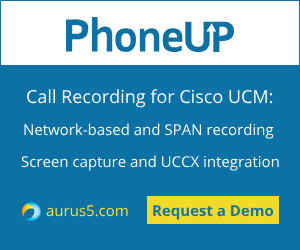 CUCM call recording is one of the most popular topics in the world of Cisco Unified Communications. For companies that deployed Cisco Unified Communications Manager there are several approaches to phone call recording offered by a dozen of Cisco Solution Partners.
CUCM call recording is one of the most popular topics in the world of Cisco Unified Communications. For companies that deployed Cisco Unified Communications Manager there are several approaches to phone call recording offered by a dozen of Cisco Solution Partners.
Which one to choose and why? Let’s consider briefly.
Call Recording Methods
- SPAN-based recording (“passive recording”) – is one of the oldest methods of CUCM voice recording. This type of recording software connects to the SPAN (Switched Port Analyzer) port to monitor all network (or VLAN only) traffic and pick out the VoIP packets to store them as audio files.
- Built-in Bridge recording (“BIB recording”) – is the approach that uses the conference bridge embedded in almost each Cisco IP phone (and Cisco Jabber for Windows as well). With the proper CUCM configuration a Cisco IP phone forks the phone call audio streams to the CUCM recording software that mixes these streams and saves to the audio file.
In the beginning of 2011 Cisco introduced its own recording platform Cisco MediaSense. This solution records audio streams forked by Cisco IP Phones (BIB-recording) or (this is important!) Cisco ISR routers.
Why is it important? Along with Cisco MediaSense Cisco released the new IOS ( Cisco ISR router firmware) that supports the media forking capability. Supplied with this feature, the Cisco gateway can fork the media of conversations to the recording server.
Which leads us to the 3rd method:
- CUBE recording – the same as BIB-recording, but the media is forked by Cisco CUBE (the software that runs on Cisco ISR router). If Cisco MediaSense can receive and store forked audio streams, why 3rd party recorders cannot?
So, what method to use and which solution to choose for Cisco CallManager recording?
Choosing the Call Recording Approach
Improve the MediaSense user experience with free PhoneUP promo-license which includes MediaSense Gateway module for unlimited number of seats.
Use BIB recording for all endpoints with built-In bridge on board. Without doubts this is the most reliable approach which also provides the more detailed info about a call.
Use CUBE recording for recording the other media (3rd party SIP devices, analogue phones connected with the voice gateway, CTI-ports, etc.) if your Cisco router supports media forking.
Use SPAN in all other cases, for example – when you don’t have a forking CUBE or you need to record internal calls of endpoints without BIB (the voice traffic is not going through the Cisco gateway).
Choosing the Recording Server
If you have to use the SPAN-recording method you are forced to choose a CUCM recording 3rd party solution.
If IP phone built-in bridges and CUBE can fork everything you need to record, then Cisco MediaSense looks like quite a tempting choice. But from the users’ perspective it only provides a very simple “Search and Play” web-interface - a password-protected web page with call recordings list and basic search capabilities. It is enough for small installations, but most of deployments need a 3rd party call recording solution that integrates with Cisco MediaSense and provides the more convenient user interface with additional features like access rights management, advanced search capabilities and so on.
Some of call recording software vendors added the Cisco MediaSense connector to their solutions. This allows using a 3rd party call recording app to manage Cisco MediaSense recordings and provide users with the rich-featured interface.
